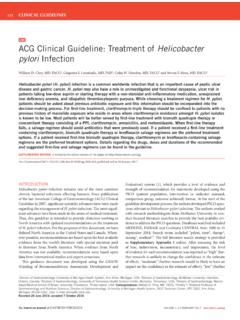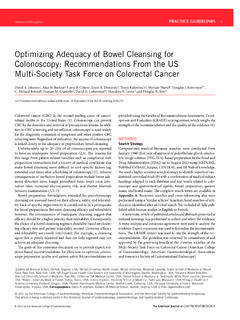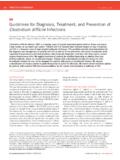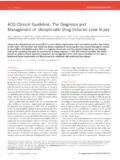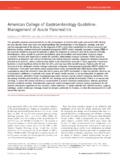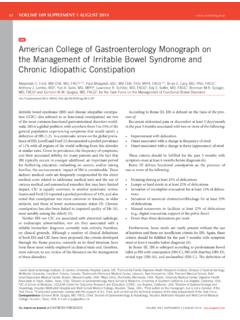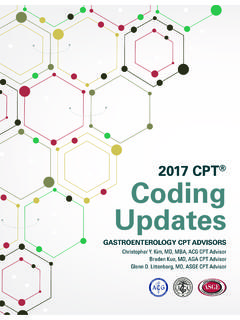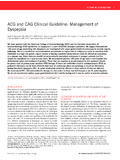Transcription of ACG Clinical Guideline: Management of Crohn’s ... - …
1 2018 by the American College of Gastroenterology The American Journal of GASTROENTEROLOGY481 Clinical GUIDELINES INTRODUCTION Crohn s disease has been increasing in incidence and prevalence worldwide. At the same time, the number of therapeutic options is rapidly increasing. Th e purpose of this guideline is to review Crohn s disease Clinical features and natural history, diagnostics, and therapeutic interventions. To prepare this guideline, literature searches on the diff erent areas were conducted using Ovid MEDLINE from 1946 to 2018, EMBASE from 1988 to 2018, and SCOPUS from 1980 to 2018. Th e major terms that were searched were Crohn s disease, infl amma-tory bowel diseases (IBD), regional ileitis, and regional enteritis.
2 Th ese were translated into EMTREE controlled vocabulary as enteritis and Crohn s disease. Th e remainder of the search included key words related to the subject area that included Clinical features, natural history, diagnosis, biomarkers, treatment, and therapy. For each of the therapeutic sections, key words included the individ-ual drug names. Th e results used for analysis were limited to pri-mary Clinical trials, meta-analyses, systematic reviews, and prior guidelines. Where there were limited data, abstracts were used. In many areas reviewed, there were not available Clinical trial data, and these areas are discussed as summary statements rather than GRADE statements.
3 To evaluate the level of evidence and strength of recommen-dations, we used the Grading of Recommendations Assessment, ACG Clinical Guideline: Management of Crohn s Disease in Adults Gary R. Lichtenstein , MD, FACG 1 , E d w a r d V . L o ft u s J r , M D , F A C G 2 , Kim L. Isaacs , MD, PhD, FACG 3 , Miguel D. Regueiro , MD, FACG 4 , Lauren B. Gerson , MD, MSc, MACG (GRADE Methodologist) 5 , and Bruce E. Sands , MD, MS, FACG 6 Crohn s disease is an idiopathic infl ammatory disorder of unknown etiology with genetic, immunologic, and environmental infl uences.
4 The incidence of Crohn s disease has steadily increased over the past several decades. The diagnosis and treatment of patients with Crohn s disease has evolved since the last practice guideline was published. These guidelines represent the offi cial practice recommendations of the American College of Gastroenterology and were developed under the auspices of the Practice Parameters Committee for the Management of adult patients with Crohn s disease. These guidelines are established for Clinical practice with the intent of suggesting preferable approaches to particular medical problems as established by interpretation and collation of scientifi cally valid research, derived from extensive review of published literature.
5 When exercising Clinical judgment, health-care providers should incorporate this guideline along with patient s needs, desires, and their values in order to fully and appropriately care for patients with Crohn s disease. This guideline is intended to be fl exible, not necessarily indicating the only acceptable approach, and should be distinguished from standards of care that are infl exible and rarely violated. To evaluate the level of evidence and strength of recommendations, we used the Grading of Recommendations Assessment, Development, and Evaluation (GRADE) system. The Committee reviews guidelines in depth, with participation from experienced clinicians and others in related fi elds. The fi nal recommendations are based on the data available at the time of the production of the document and may be updated with pertinent scientifi c developments at a later time.
6 SUPPLEMENTARY MATERIAL is linked to the online version of the paper at Am J Gastroenterol 2018; 113:481 517; doi: ; published online 27 March 2018 1 Department of Medicine, Division of Gastroenterology, Hospital of the University of Pennsylvania, Perelman School of Medicine of the University of Pennsylvania , Philadelphia , Pennsylvania , USA ; 2 Division of Gastroenterology and Hepatology, Mayo Clinic , Rochester , Minnesota , USA ; 3 Department of Medicine, Division of Gastroenterology, University of North Carolina Chapel Hill , Chapel Hill , North Carolina , USA ; 4 Department of Gastroenterology and Hepatology, Cleveland Clinic , Cleveland , Ohio , USA ; 5 Department of Medicine, Division of Gastroenterology, California Pacifi c Medical Center , San Francisco , California , USA ; 6 Dr Henry D.
7 Janowitz Division of Gastroenterology, Icahn School of Medicine at Mount Sinai , New York , New York , USA ; Deceased . Correspondence: Gary R. Lichtenstein, MD, FACG, Hospital of the University of Pennsylvania, University of Pennsylvania School of Medicine, Gastroenterology Division , 7th Floor, South Perelman Building, Room 753, 3400 Civic Center Boulevard , Philadelphia , Pennsylvania 19104-4283 , USA . E-mail: Received 11 June 2017 ; accepted 11 January 2018 CMEL ichtenstein et al. The American Journal of GASTROENTEROLOGY VOLUME 113 | APRIL 2018 482 Development, and Evaluation (GRADE) system ( 1 ). Th e level of evidence could range from high (implying that further research was unlikely to change the authors confi dence in the estimate of the eff ect), moderate (further research would be likely to have an impact on the confi dence in the estimate of eff ect), low (fur-ther research would be expected to have an important impact on the confi dence in the estimate of the eff ect and would be likely to change the estimate), or very low (any estimate of eff ect is very uncertain).
8 Th e strength of a recommendation was graded as strong when the desirable eff ects of an intervention clearly outweigh the undesirable eff ects and as conditional when there is uncertainty about the trade-off s. We preferentially used meta-analyses or systematic reviews when available, followed by Clinical trials and retrospective cohort studies. To determine the level of evidence, we entered data for the papers of highest evidence into the GRADE program (accessible at ). Th e GRADE recommendations statements from this guideline are in Ta b l e 1 . Summary statements are descriptive and do not have associated evidence-based ratings ( Ta b l e 2 ).
9 In this guideline, the numbered statements are the GRADE statements and the unnum-bered statements relate to summary statements. Clinical FEATURES Hallmark/cardinal symptoms of Crohn s disease include abdominal pain, diarrhea, and fatigue; weight loss, fever, growth failure, anemia, recurrent fi stulas, or extraintestinal manifestations can also be presenting features ( Summary Statement ). Th e most common symptom of Crohn s disease is chronic diarrhea, but some patients may not experience this symptom ( 2 ). Abdominal pain, oft en localized to the right lower quad-rant of the abdomen and worsened postprandially, is common. Fatigue is also a very prevalent symptom in Crohn s disease and is thought to arise from a number of factors including infl amma-tion itself, anemia, or various vitamin and mineral defi ciencies.
10 Some patients will present with constitutional signs or symptoms including fever, weight loss or, in the case of younger patients, growth failure. Crohn s disease is diagnosed clinically. Th ere are no truly pathog-nomonic features. Endoscopic, radiographic, and histologic criteria with evidence of chronic intestinal infl ammation will be present (Summary Statement). Th e clinician must integrate multiple streams of informa-tion, including history and physical, laboratory tests, endoscopy results, pathology fi ndings, and radiographic tests, to arrive at a Clinical diagnosis of Crohn s disease. In general, it is the presence of chronic intestinal infl ammation that solidifi es a diagnosis of Crohn s disease.
